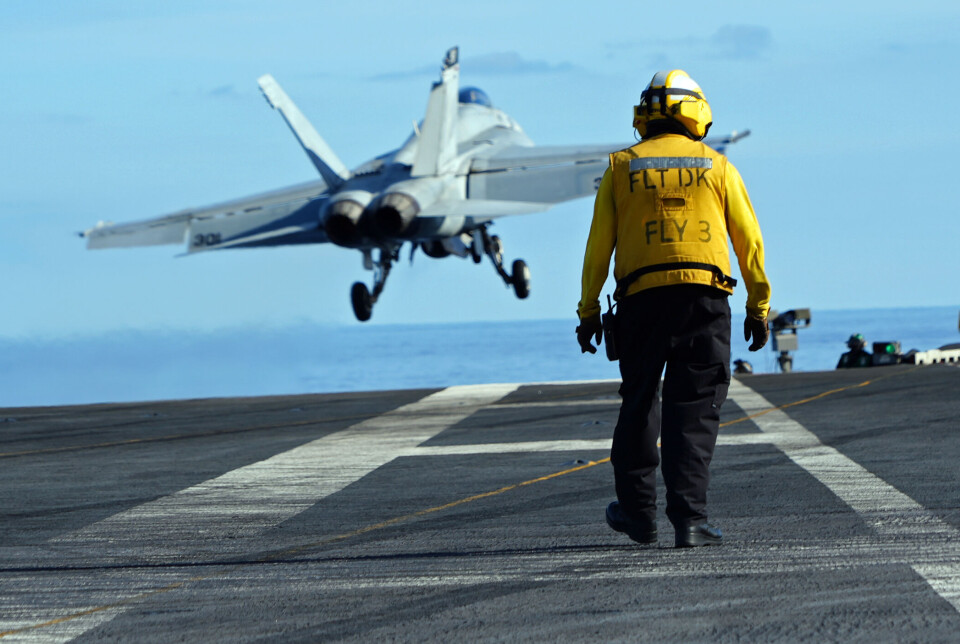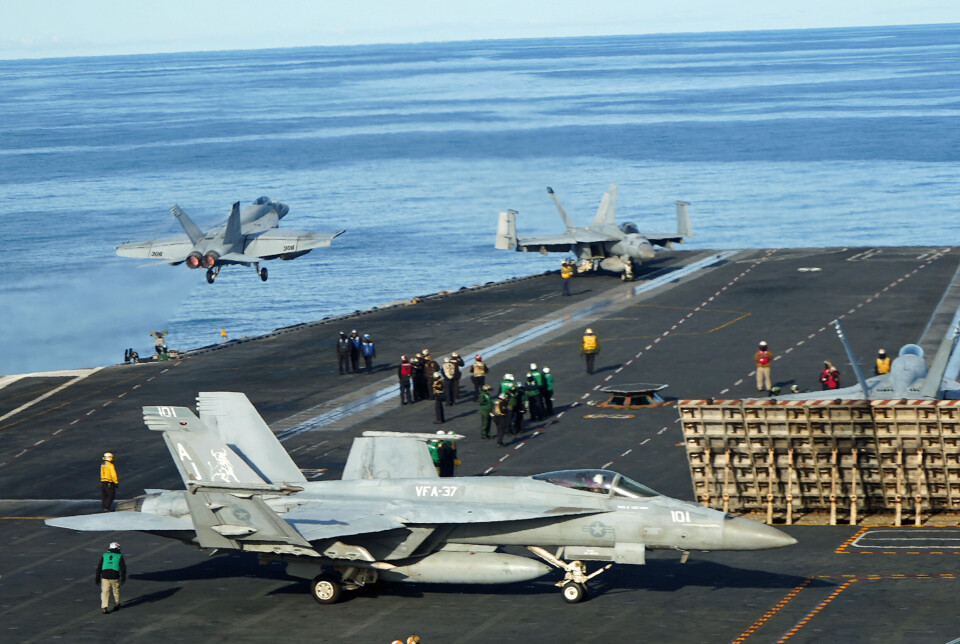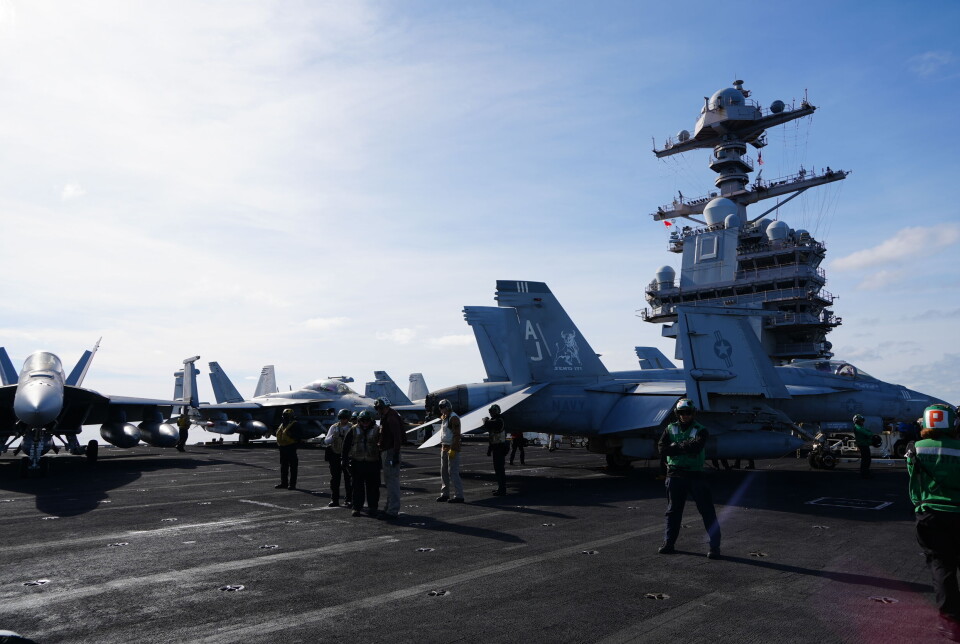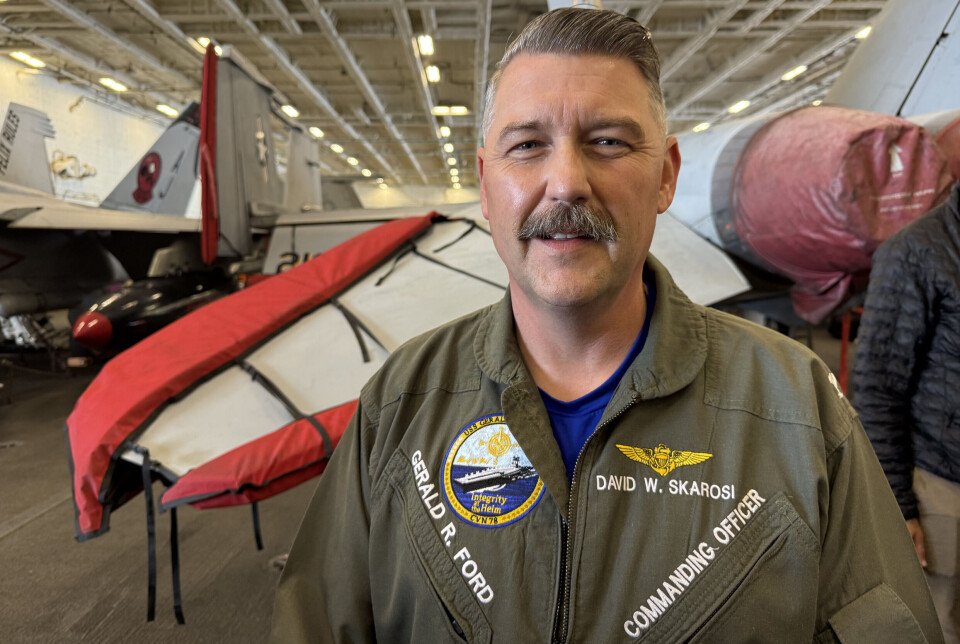
Massive NATO show of force in Nordic region sends message to Russia
THE NORTH SEA: The Barents Observer was aboard the USS Gerald R. Ford on Wednesday as fighter jets took off for exercise bombing missions from the North Sea to the southern coast of Finland. The show of force follows a recent mission by the aircraft carrier to deter Russia inside the Arctic Circle.
The bombing mission is the first time fighter jets have flown from an aircraft carrier in the North Sea to reach a target at the entrance to the Gulf of Finland, the easternmost arm of the Baltic Sea.
"We can fly the F-18s 1,000 miles (1,600 km), and even longer with aerial refuelling. No problem to reach Finland," said Capt. David J. Dartez, commander of the Air Wing Eight which is attached to the aircraft carrier USS Gerald R. Ford. We spoke to the commander in the ready room, the compartment just below the flight deck where aircrew conduct their pre-flight and post-flight briefs.
On the wall next to the board are two hand-pointers; one with an F/A-18, the other with a Sukhoi Su-27. There are few doubts about who the adversary is.
After delivering the bombs to the Hästö-Busö exercise area in Finland, the F/A-18s returned to the aircraft carrier. The mission was an integrated part of NATO's Neptune Strike enhanced vigilance activity involving sailors, soldiers, aviators, and marines from 13 nations.
Although planned for a long time, the timing of the NATO drill was opportune. Russian aircraft have repeatedly violated the airspace of their Nordic and Baltic neighbours, actions NATO said are "part of a wider pattern of increasingly irresponsible Russian behaviour."
In parallel events not necessarily linked in response to NATO's Neptune Strike, there have been drone sightings over several days, affecting airports and military installations in Denmark. Authorities said a "professional actor" was responsible.
With a special focus on the Nordic-Baltic region, the Neptune Strike is designed to demonstrate NATO’s ability to integrate high-end maritime strike capabilities, strengthen deterrence, and ensure freedom of navigation across critical waterways.
Other parts of Neptune Strike took place in the Mediterranean and Adriatic Seas. For NATO, bolstering the eastern flank is a priority.
Norwegian military officials told the Barents Observer that the security up North is closely linked with what happens in the Baltic region.
While both Denmark and Norway are founding members of the North Atlantic Treaty Organization (NATO), Finland and Sweden decided to join after Russia's full-scale invasion of Ukraine in 2022.

Despite concerns in Europe about Donald Trump's commitment to NATO's mutual defence clause, the United States military is very much present in the Nordic region. When the USS Gerald R. Ford sailed into the Oslo fjord in the spring of 2023, it was the first U.S. aircraft carrier to visit Norway in 65 years. In 2024, the USS Harry S. Truman made a similar visit and in September this year, the USS Gerald R. Ford again visited Oslo after a deployment to the waters outside northern Norway.
The carrier strike group's operations in the Norwegian- and Barents Seas followed a larger Russian Northern Fleet manoeuver and came ahead of the joint Belarus-Russia Zapad-2025 (West-2025) strategic exercise this fall. Simultaneously as the Gerald R. Ford conducted joint activities with Norway and other NATO allies outside Lofoten and Tromsø, all three Northern Fleet Yasen-class multipurpose submarines were at sea.
Russia also sent long-range military planes to outside Norway.
"NATO has chosen a provocative course by intensifying its member states' military activities in the High North," Moscow's Embassy in Oslo said in a statement posted on Facebook, a social media platformed banned inside Russia.
The Embassy said that Norway and NATO's exercises "increase tension and pose a risk of further escalation of the military situation in the region."
Air wing commander Dartez confirmed to the Barents Observer that Russian maritime aircraft indeed approached the aircraft carrier when it was outside northern Norway.
"Norway’s F-35 did a fantastic job, they were called to intercept that maritime aircraft right away and there was a very successful handoff by the Norwegian F-35s to our F-18s when the maritime aircraft came and flew around the strike group," Capt. Dartez said.
He said that any possible picture the Russian planes could take would include at least one F/A-18 in it.
"We had custody of them the entire time. They did not get within any range without us on the wing," the commander said.

The Gerald R. Ford nuclear-powered aircraft carrier is the world's largest warship.
It can carry more than 75 aircraft and has a crew of about 4,500 sailors. The top speed is 30 knots.
Aircraft are launched with the carrier's catapult system. It can launch two aircraft and land one every 37 seconds in daylight, slightly slower at night.
Commanding officer aboard the Ford, Capt. David W. Skarosi, said they learned a lot from the challenging conditions outside northern Norway,
"We did multiple recoveries in very limited visibility, as the weather could change rapidly. The professionals on the flight deck and our carrier air traffic controller did a super job handling that challenge," Skarosi said to the Barents Observer.
The purpose of the voyage was to train Arctic operations with NATO allies.
"Norway and Finland are the experts," David W. Skarosi said. "We learned from them every single day, leveraging their experience and understanding how to operate up there seamlessly is vital to our execution and the endurance of our alliance."
He confirmed that the strike group kept control of the Russian submarines that were in the area.
"Yes, we had our destroyers with the German and the French ships to make sure that the Ford was well aware of what was happening around us at all times."

NATO’s Article 4 has been invoked two times in September. First after Russian drones entered Polish airspace, and the second time after three armed Russian MiG-31 fighter jets violated Estonian airspace for more than 10 minutes.
“Russia bears full responsibility for these actions, which are escalatory, risk miscalculation and endanger lives. They must stop,” the North Atlantic Council said in a statement shortly after.
The Alliance noted that violations of air space had taken place in Finland, Latvia, Lithuania, Norway and Romania as well. For Norwegians, the NATO statement came as a surprise as officials in Oslo had previously not informed the public about three violations in the Varanger region by Russian planes earlier this spring and summer.
The region borders with the Kola Peninsula, home to a substantial part of Moscow’s nuclear weapons, including ballistic missiles and tactical nukes designed for Navy cruise missiles.
NATO said its response to Russia's "reckless actions" will continue to be robust.
"Russia should be in no doubt: NATO and Allies will employ, in accordance with international law, all necessary military and non-military tools to defend ourselves and deter all threats from all directions."
Several European diplomats warned Moscow this week that they are prepared to shoot down Russian planes if severe intentional air space violations continue. Also, Donald Trump this week said he supports NATO nations shooting down Russian aircraft that enter their airspace.
Kremlin spokesman Dmitri Peskov denounced the statements, calling them “irresponsible and reckless.”
Meanwhile, Russia has over the past weeks expanded its strikes with drones and cruise missiles, targeting several regions of Ukraine. Moscow shows no intension to end the brutal war it started by its own choice.
In its statement condemning Russia's air space violations, NATO made clear its allies will "not be deterred by these and other irresponsible acts by Russia from their enduring commitments to support Ukraine, whose security contributes to ours, in the exercise of its inherent right to self-defence against Russia’s brutal and unprovoked war of aggression."
Foreign Minister Sergei Lavrov, who attended the U.N. General Assembly in New York this week, said Moscow is in a "real war" with Europe and NATO, state-owned propaganda agency TASS reported.
"A clear example is the crisis in Ukraine, provoked by the collective West, through which NATO and the European Union want to declare, in fact, have already declared a real war on my country and are directly participating in it," Lavrov said.
The Barents Observer underlines that what Lavrov said is not true. It is widely known that the Russian Foreign Minister is infamous for lying about the war in Ukraine.

































